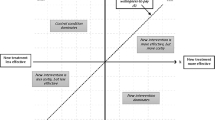Abstract
Resource allocation decisions are often made on the basis of clinical and cost effectiveness at the expense of ethical inquiry into what is acceptable. This paper proposes that a more compassionate model of resource allocation would be achieved through integrating ethical awareness with clinical, financial and legal input. Where a publicly-funded healthcare system is involved, it is suggested that having an agency that focuses solely on cost-effectiveness leaving medical, legal and ethical considerations to others would help depoliticise rationing decisions and command greater public acceptance.
Similar content being viewed by others
REFERENCES
Alexander, M. (1999, February, 18) Real Democracy Demands a Willingness to Listen to Genuine Local Voices. Health Service Journal, p.19.
BBC News. (2002) Outrage Over Blindness Guidelines. Http://news.bbc.co.uk/hi/english/health/ newsid 2041000/2041525.stm
Bell, A. (2000) It's Not Fair: Issues of Equity in NHS Health Care. British Journal of Health Care Management 6(12), 580–581.
Black, M., and Mooney, G. (2002) Equity in Health Care from a Communitarian Standpoint. Health Care Analysis 10, 193–208.
Blumstein, J.F. (1997) The Oregon Experiment: The Role of Cost-Benefit Analysis in the Allocation of Medicaid Funds. Social Science Medicine 45(4), 545–554.
British Medical Association. (2001) Healthcare Funding Review. London: BMA.
Butler, J. (1999) The Ethics of Health Care Rationing: Principles and Practices. London: Cassell.
Campbell, A., Charlesworth, M., Gillett, G., and Jones, G. (1997) Medical Ethics (2nd edn.). Oxford: Oxford University Press.
Campbell, T. (1999) Human Rights: A Culture of Controversy. Journal of Law and Society 26(1), 6–26.
Devlin, B. (2003, March) The Ethical Option. Health Management, pp. 10–12.
Dickenson, D. (1999) Can Medical Criteria Settle Priority-Setting Debates? The Need for Ethical Analysis. Health Care Analysis 7, 131–137.
Dixon, J., and Welch, H.G. (1991) Priority Setting: Lessons from Oregon. The Lancet 337, 891–894.
Dworkin, R. (2000) Sovereign Virtue: The Theory and Practice of Equality. London: Harvard University Press.
Harris J. (1997) The Case Against: What the Principal Objective of the NHS Should Really Be. BMJ 314, 669–672.
Harris, J. (1999) Justice and Equal Opportunities in Health Care. Bioethics 13(5), 392–404.
Highland NHS Board. (2002) Ethical Decision Making: A Framework for Ethical governance. Inverness, Scotland, UK Highland NHS Board.
Holt, S. (2002, June, 19) Letters: Beyond belief. Daily Mail.
Jonsen, A.R. (1990) The New Medicine and the Old Ethics. London: Harvard University Press.
Jonsen, A.R., Siegler, M., and Winslade, W.J. (1998) Clinical Ethics: A Practical Approach to Ethical Decisions in Clinical Medicine (4th edn.). New York: McGraw Hill.
Kennedy, I. (Chair) (2001) Bristol Royal Infirmary Inquiry Final Report. London: The Stationery Office.
Klein, R. (1993) Dimensions of Rationing: Who Should Do What Next? BMJ 307, 309–311.
Klein, R., Day, P., and Redmayne, S. (1996) Managing Scarcity: Priority Setting and Rationing in the National Health Service. Oxford: Oxford University Press.
Kluge, E.-H.W., and Tomasson, K. (2002) Health Care Resource Allocation: Complicating Ethical Factors at the Macro-Allocation Level. Health Care Analysis 10, 209–220.
Kuczewski, M.G. (1997) Fragmentation and Consensus: Communitarian and Casuist Bioethics. Washington, DC: Georgetown University Press.
Loewy, E.H. (1999) Justice and Health Care Systems: What Would an Ideal Health Care System Look Like? Health Care Analysis 6, 185–192.
Mannion, R., and Small, N. (1999) Postmodern Health Economics. Health Care Analysis 7, 255–272.
Marsh, B. (2000, May, 6) Ordeal for Thousands Over Breast Cancer Drug. Daily Mail.
Millar, B. (1999, March, 18) Race Against Time. Health Service Journal, pp. 9–10.
National Institute for Clinical Excellence. (2000) Press Release: NICE Issues Guidance on Taxanes for Ovarian Cancer (NICE 2000/013). London: NICE.
National Institute for Clinical Excellence. (2002a) Final Appraisal Determination: Photodynamic Light Therapy for Age-Related Macular Degeneration (2002/033). London: NICE.
National Institute for Clinical Excellence. (2002b) Press Statement 2002/033 NICE has Not Issued Guidance or Recommendations to NHS on Photodynamic Therapy. London: NICE.
Romanow, R.J. (Commissioner) (2002) Building on Values: The Future of Health Care in Canada: Final Report. Ottawa: Commission on the Future of Health Care in Canada.
Stoll, B.A. (Ed.). (1989) Ethical Dilemmas in Cancer Care. Basingstoke, UK: Macmillan.
Subramanian, K.N., and Paul, V.K. (1995) Care of Critically Ill Newborns in India. Journal of Legal Medicine 16, 263–275.
Weir, R.F. (1989) Abating Treatment with Critically Ill Patients: Ethical and Legal Limits to the Medical Prolongation of Life. New York: Oxford University Press.
Author information
Authors and Affiliations
Rights and permissions
About this article
Cite this article
Terry, L.M. An Integrated Approach to Resource Allocation. Health Care Analysis 12, 171–180 (2004). https://doi.org/10.1023/B:HCAN.0000041189.67995.96
Issue Date:
DOI: https://doi.org/10.1023/B:HCAN.0000041189.67995.96



